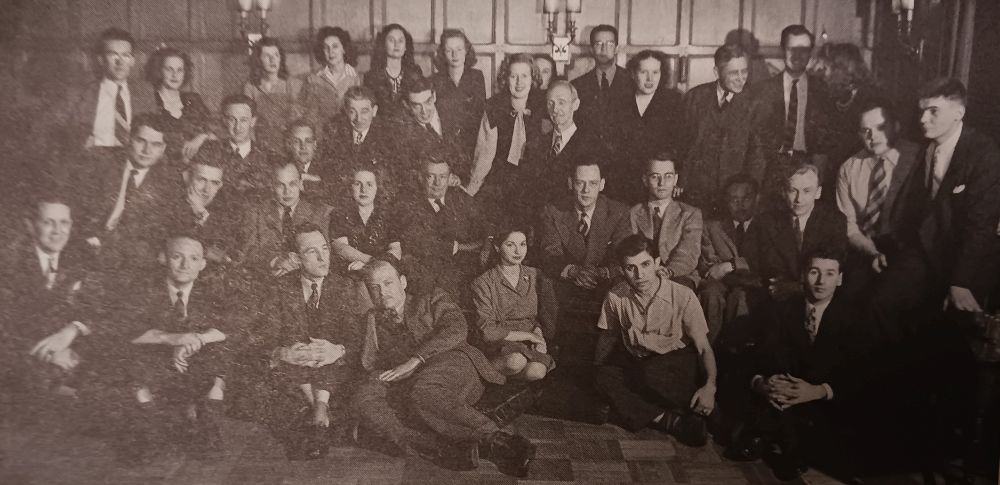
[Image above] Photograph of project members at the 1944 Christmas party. A list of everyone’s names can be found in the article PDF. Credit: Osgood J. Whittemore and Louis R. McCreight, The American Ceramic Society
With a runtime of just more than three hours, the summer blockbuster “Oppenheimer” is an ambitious and admirable attempt to cover the multilayered and divisive history of the Manhattan Project, which resulted in the world’s first atomic bombs.
Of course, including every nuanced detail from this transformative period is not possible in just a few hours. But the movie will ideally leave the audience “with some unsettling questions and some troubling issues” that will lead them to learn more about this history on their own, according to “Oppenheimer” director Christopher Nolan.
Several prominent news organizations have already taken the chance to publish stories on some of the people involved in the Manhattan project who were omitted from or vastly underdeveloped in the film. For example, The Washington Post, Business Insider, and Vogue, among other publications, highlighted several women scientists who played key roles in the project.
When ACerS staff member Greg Geiger saw “Oppenheimer,” he remembered that The American Ceramic Society previously helped to uncover some of the Manhattan Project’s hidden history in an article from Volume 5 of the ACerS “Ceramics and civilization” book series.
This volume, titled “The changing roles of ceramics in society: 26,000 B.P. to the present” (1990), contains proceedings from a Society Symposium on History and Archaeology held at the 90th Annual Meeting in 1988.
The final article in the historical studies section, written by the late ACerS Fellows Osgood J. Whittemore (University of Washington) and Louis R. McCreight (Aerospace Corporation), is “Ceramics and ceramists on the Manhattan Project: A narrative of activities at M.I.T. from 1944 to 1946.”
At the time of the Manhattan Project, commercially available crucibles of satisfactory purity for melting and refining the nuclear metals were not available. So, a ceramic division of the Massachusetts Institute of Technology Metallurgy Project, which was part of the Manhattan Project, was organized to develop the required refractories.
The ceramics division consisted of four principal groups: the production group, the dense oxides group, the sulfides group, and the nitrides group. In less than two years, the groups successfully developed crucibles from magnesium oxide, beryllium oxide, thorium dioxide, cerium sulfide, and thorium sulfide. A few small crucibles of titanium nitride were produced, but the work was discontinued due to the pressures of preparing the oxide and sulfide crucibles.
The article includes both scientific details from the project as well as humorous stories concerning the project’s personnel. For example,
- Army Student Training Program (ASTP). When the project required additional personnel, ASTP engineering students from several universities were brought in. These students, who had not yet finished their bachelor’s degrees, originally wore civilian clothes but later were required to wear Army uniforms. This change in dress requirements led one of the ASTP students, who were allowed to room where they pleased, to be reported as a deserter.
- Firing the crucibles. In a paragraph describing how crucibles were fired, the article states that “The kilns were often warm enough to cause Lou’s [the author’s] hair oil to smoke during the loading operation!”
- Security. After about a year of operation, about three-fourths of a ton of scrap crucibles had accumulated. There was concern that someone could analyze the scraps and gain information about the project, so it was decided that the scraps would be hauled out into the Atlantic Ocean for disposal. When several project personnel went out on a Navy ocean-going tug to conduct this disposal, the FBI man who accompanied them as a guard “was upset with people for skimming some flat disc-shaped crucible covers over the waves!”
There are many more valuable insights and entertaining stories included in the 15-page article, which you can read for yourself at this link.
If there is a person who you expected to see mentioned but didn’t, “we apologize to those we missed—44 years is a long time!” Whittemore and McCreight conclude their article.
